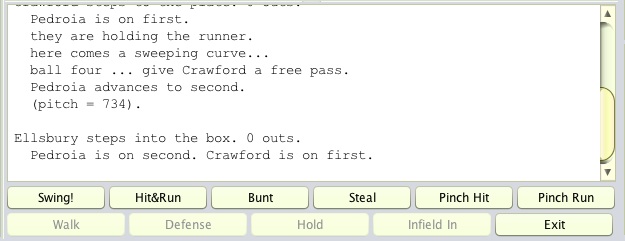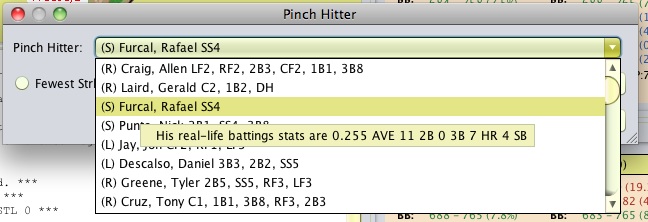Offensive Decisions
The offensive manager can choose from up to six different defensive decisions when managing their team. Decisions are made by clicking on one of the enabled buttons located in the Control panel. The Control panel is visible at the bottom of the Play tab, but only when a game is in underway.
 |
|
The following list describes each of these managerial moves in more detail:
- Swing!: This button will commence the battle between the pitcher and the batter. The result of the confrontation will be displayed in the Message window located just above the Control pane.
- Hit&Run: This button will initiate a hit and run play. When the hit-and-run is on, the batter's ability to get a hit is reduced because they will try to protect the runner. If it is a ground ball out and the hit-and-run is on, the runners are less likely to get thrown out, so it is a great way to stay out of a double play. However, the runner can get doubled up if the hit-and-run is on, and a line drive is hit! In addition, if the batter strikes out when the hit-and-run is on, the runner is more likely to get thrown out than a straight steal. Finally, runners are more likely to take an extra base if they are involved in a hit-and-run. You cannot hit-and-run if there is a runner on third or there is nobody on base. Several general options control how the hit-and-run affects game play (see General Options for more details).
- Bunt: The Bunt button allows the manager to call for a sacrifice bunt. Managers can only call for a sacrifice bunt if there are runners on base and fewer than two outs. The Bunt button will be disabled in all other situations. If the bases are loaded when a sacrifice bunt is called for, the bunt will result in a squeeze play. If the bases are not loaded, and there is a runner on third, the manager will be asked if they want to engage a squeeze play. If a squeeze play is called, all runners will attempt to advance, including the runner on third. If a squeeze is not called for, the runner will stay on third and all other runners will attempt to advance. An unsuccessful bunt will result in the advancing leader runner being thrown out and all other trailing runners advancing one base. The chance for a successful bunt or squeeze play is determined by the the bunt rating of the current batter and the General options. (see How Ratings are Calculated and General Options for more information).
- Steal: The Steal button allows the manager to call for a stolen base. A stolen base can only be requested by the manager when there is is a runner first, or second, or both first and second. If there is a runner on both first and second the manager will be asked if they want to call for a double steal. If the manager calls for a double steal, both runners will attempt to steal a base. Otherwise, only the lead runner will attempt the setal. After Steal button is pressed, the lead runner will attempt to get a good lead. If the lead runner cannot get a good lead, they will not be allowed to attempt a steal until the next batter comes to the plate. If the lead runner does manage to get a good lead, the steal attempt will commence. The chance for a successful lead is determined by the steal rating of the current batter and the General options. (see How Ratings are Calculated and General Options for more information).
- Pinch Hit: This button will
display the Pinch Hitter dialog, which
will allow the offensive manager to pinch hit for the current
batter.

The Pinch Hitter dialog provides the manager with some tools for selecting the best option based on fewest strikeouts, on-base percentage, extra base hitting, and home run ability. To ask the computer to suggest a pinch hitter, select the criteria you want the computer to use when making its selection and then click on the Suggest button. The suggested pinch hitter will be displayed in the Pinch Hitter drop-down list box. Of course, you are welcome to disregard the computer's selection and pick any pinch hitter you want using the Pinch Hitter list box.
The Matchups button (also located on the Pinch Hitter dialog) displays the Matchups dialog box, which is designed to provide you with the information you need to make the best managerial decisions. Please see Matchups for more information about how to take full advantage of the Matchups dialog box. NOTE: you can also hover any player in the Pinch Hitter drop-down list box to get a summary of their real life batting statistics.

At the end of any inning in which a pinch hitter has been used, the Defensive Substitutions dialog box will be displayed and the manager will be asked to update their lineup so that all positions are covered (see Defensive Decisions for more information). - Pinch Run: The
Pinch Run button will display the
Pinch Runner dialog, which will allow the offensive manager
to pinch run for one of the current base runners. The
Pinch Run button is only enabled if
there is at least one runner on base.

If more than one runner is on base, the Pinch Runner dialog box allows the manger to select which runner they would like to replace. The Matchups button (also located on the Pinch Runner dialog) displays the Matchups dialog box, which is designed to provide you with the information you need to make the best managerial decisions. Please see Matchups for more information about how to take full advantage of the Matchups dialog box.
At the end of any inning in which a pinch runner has been used, the Defensive Substitutions dialog box will be displayed and the manager will be asked to update their lineup so that all positions are covered (see Defensive Decisions for more information). - Exit: This button will allow the manager to end the game. If you exit a game, it will not be saved. In addition, if you are playing a scheduled game the stats that were accumulated so far during the game will not be saved.
Extra Base Attempts
If there are runners on base when a batter gets a base hit, the game engine rolls a 1000-sided die to determine if the base runners will attempt an extra base. There are three possible outcomes from this roll:
- The runners do not attempt an extra base: If the dice roll is considerably less than the success value as determined by the general running options, the runners will not attempt an extra base.
- The runners attempt an extra base and are successful: If the dice roll is considerably greater than the success value as determined by the general running options, the runners will successfully take an extra base.
- The manager will be asked if they want to risk sending the runners: If the dice roll is close to the success value as determined by the general running options, the manager (computer or human) will be asked if they want to risk sending the runners. If they decide to send the runners, the runners may be successful or the lead runner might be thrown out, depending on the roll.